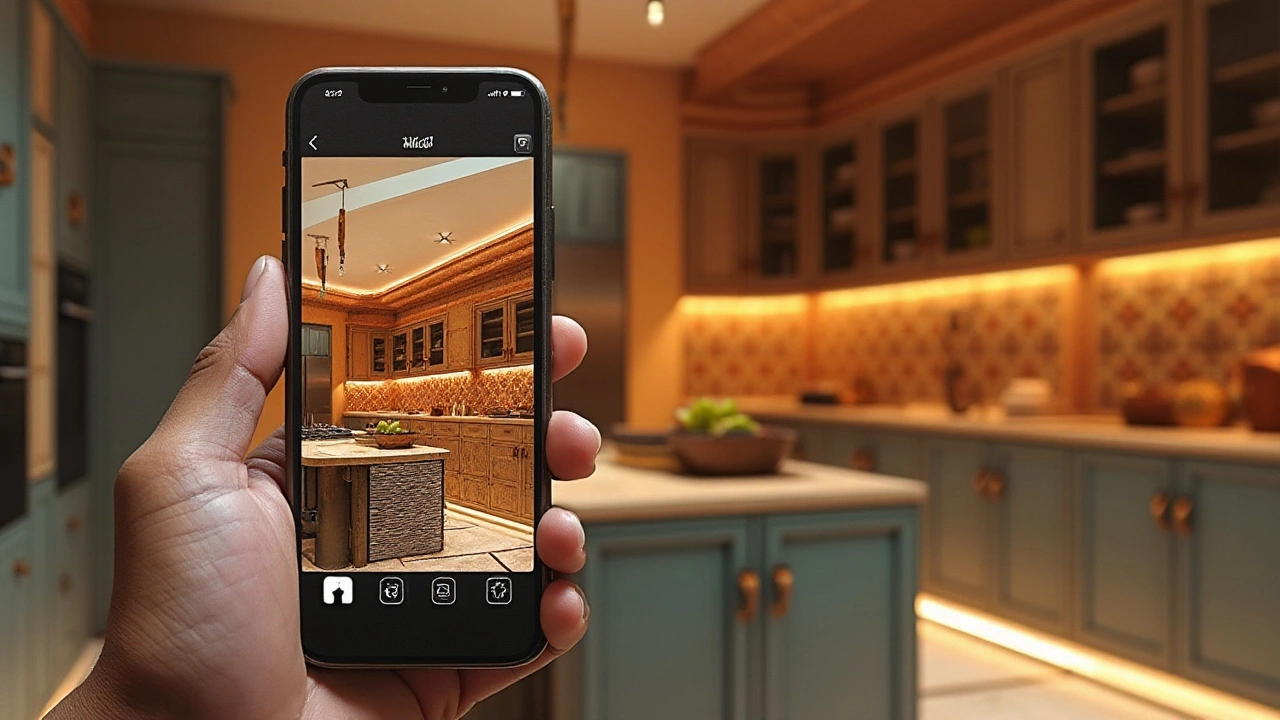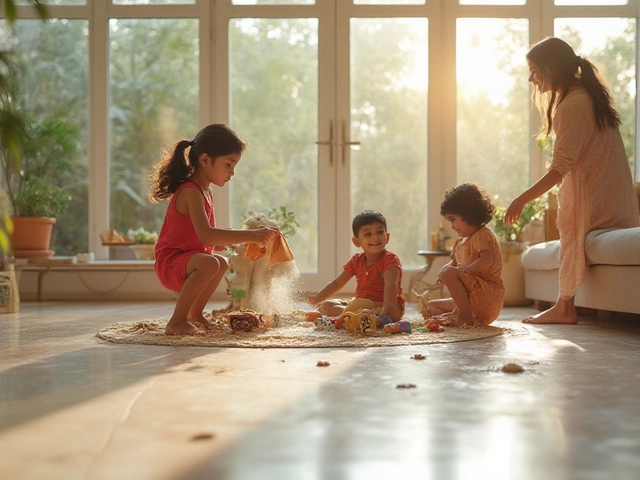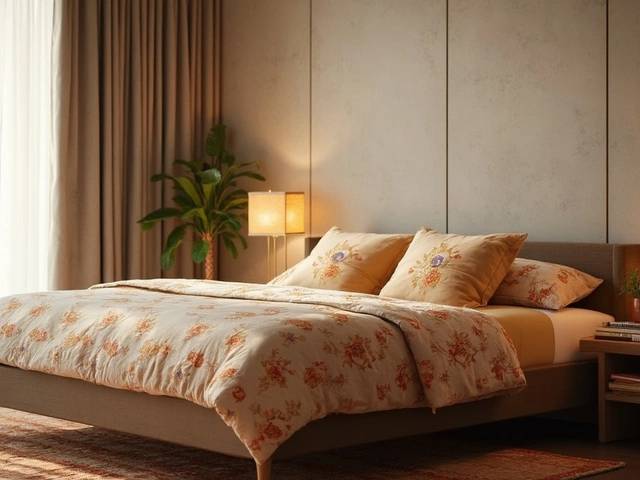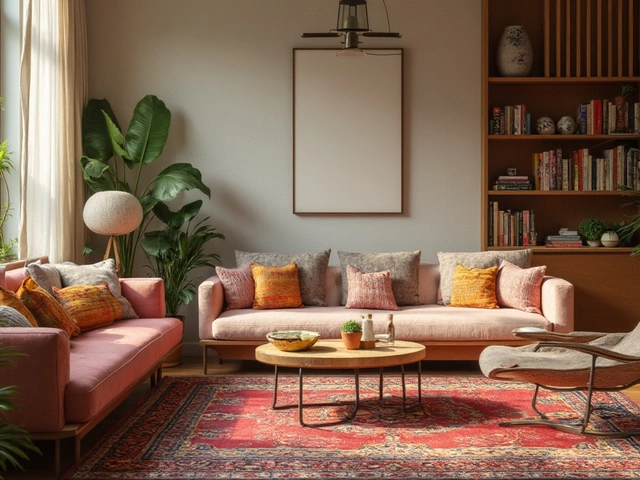In a rapidly evolving tech-driven world, even the heart of our homes isn't exempt from digitization. The kitchen, often seen as its nourishing center, now finds itself at the intersection of technology and creativity. Kitchen design apps have emerged as pivotal tools in transforming conceptual ideas into tangible designs.
Whether you're planning a minor tweak or a full-scale overhaul, there are apps tailored to meet every need. They help bring clarity to your vision by offering a virtual playground to experiment with different layouts, materials, and finishes. By the end of your digital endeavor, the path to your ideal kitchen can become less a daunting task and more an exciting journey.
- The Rise of Kitchen Design Apps
- How to Choose the Right App
- Features to Look for in Kitchen Apps
- Popular Apps for Kitchen Redesign
- Using Apps for DIY Projects
- The Future of Kitchen Design Technology
The Rise of Kitchen Design Apps
There's no question that technology has changed the way we approach many aspects of our lives, redesigning our kitchen included. The adoption of kitchen design app tools has been a game-changer in this realm, creating an accessible pathway for both professionals and DIY enthusiasts to bring their culinary space visions to life. This digital evolution has been shaped by the rapid advancement of smartphone and tablet technologies, which have made applications more intuitive and powerful. Back in the day, redesigning your kitchen often meant hiring a professional designer and facing a lengthy and often costly process. Today, however, anyone with an interest in kitchen renovation can simply download an app, and with a few taps, start visualizing different layouts and designs.
The shift towards these apps is evidenced by the steady rise in demand for them across app stores worldwide. According to a study conducted in 2023, there was a 40% increase in downloads of home design apps year over year, with a significant chunk dedicated specifically to kitchen design app platforms. Enthusiasts value these tools for their interactive and user-friendly interfaces which allow users to experiment with different styles, explore new cabinet options, and even plan where to place electrical appliances. The convenience of having these design aids right in your pocket cannot be overstated. These apps have democratized design skills, empowering even novices to become budding interior decorators at a fraction of traditional costs.
Beyond the remarkable accessibility, what truly sets these apps apart is their ability to foster creativity through a myriad of features. Most apps offer 3D modeling, a feature that enables users to virtually walk through their redesigned spaces before committing to any real-world changes. This eliminates the chance of unpleasant surprises and fosters informed decision-making. Users who deploy a kitchen remodel app gain the opportunity to see how different colors, materials, and layouts will work together harmoniously. One expert, in an article examining the growth of these applications, quipped,
"These apps are not simply tools; they are gateways to creativity and innovation in kitchen design."Indeed, for those eager to add a personal touch, some apps even allow for customized cabinetry or the integration of user-uploaded floor plans. Imagine the ease of matching your new kitchen floor to your favorite coffee mug shade before you truly invest!
The surge in popularity of these apps also speaks volumes about the broader shift in consumer behavior towards Do-It-Yourself (DIY) projects. People are increasingly looking for ways to cut costs without sacrificing quality or style. This democratization of the design process is complemented by seamless integration features, allowing homeowners to interface with contractors, designers, and home improvement stores through their apps. By bridging these connections, individuals can negotiate better deals and stay informed of trends and innovations. Such connectivity not only helps in optimizing designs but acts as a confidence booster for many who may otherwise hesitate to embark on a kitchen redesign project. This rise in smart design platforms represents a marriage between innovation and imagination, a testament to the dynamism of modern-day home improvement.
How to Choose the Right App
In navigating the world of kitchen design, finding the perfect kitchen design app is akin to selecting the right tool for the job. Not all apps are created equal, and understanding the nuances can significantly affect your redesign experience. Start by considering your project’s scope and complexity. Are you looking for a full renovation or just a change in layout? If you’re leaning towards a substantial remodel, an app that provides detailed 3D visualization and customizable design options is crucial. For those interested in smaller tweaks, an app that offers straightforward floor plan rearrangements or color palette suggestions might suffice. It’s also worth checking into customer reviews and ratings to gain insights into user satisfaction and common pitfalls that others have encountered.
Another factor to weigh in when choosing the right app is its interface and usability. The app should be intuitive, offering an easy-to-navigate platform that doesn’t feel like it requires an IT degree to operate. Many users have reported that intuitive controls were a significant determining factor for them. For instance, if drag-and-drop functionality and pinch-to-zoom are integrated, it can make virtual interactions much more pleasant. Pair that with high-quality graphics, and the app can significantly enhance your designing experience.
Don’t overlook the range of features available. Ideally, the app should cover all facets of kitchen design. This means the app should allow tweaks in layout, easy swapping of appliances, and adjustments to things like flooring and cabinetry finishes. Some apps even provide a catalog of items—applicable for budgeting purposes—that you can browse for inspiration. While assessing features, ensure the app can sync across devices or collaborate with others, which can be particularly beneficial for couples or families working on the project together.
A leading source in home improvement, Scott Hall from Architectural Digest, mentions, "A well-rounded kitchen design app should not only facilitate creativity but also incorporate practical tools that reflect real-world conditions and constraints."
It's also essential to consider platform compatibility. Does it work on your device? Some apps may require powerful devices, so check whether your tablet or phone fits the specifications. Especially with apps that offer high-def 3D renderings, having a device that can handle such graphics without lags is advantageous. Investigate whether the app is compatible with both Android and iOS if you foresee the need to switch between devices frequently.
Lastly, pricing models can vary considerably, from free versions that act as demos to premium options that can be costly. Some apps offer a one-time purchase, while others may have a subscription-based model. Understanding how each pricing option benefits your needs ensures that you don't overpay for features you won’t use. A useful tip is to trial multiple apps that offer free versions before committing financially. This test can reveal the app that truly meets all your needs while also fitting your financial plan for the renovation.
As technology continues to evolve, so too do our options for transforming the pivotal spaces in our homes. Using a strategic approach in selecting the right app could make the journey from dream to reality smoother and more enjoyable. Take your time to explore, test, and find the app that speaks to your vision and meets your kitchen redesign needs.
Features to Look for in Kitchen Apps
The digital landscape has broadened the ways we approach kitchen remodels, and choosing the right app can significantly influence the ease and success of your project. When embarking on the search for the perfect kitchen design app, several core features are crucial to consider. Firstly, visualization tools are paramount. High-quality apps offer robust 3D modeling capabilities, providing a near-realistic visualization of how different elements will look. This aspect is particularly beneficial as it allows any homeowner to envisage their dream-kitchen unfolding before their eyes, right down to the smallest detail like cabinet textures or countertops.
Another important feature is a rich library of kitchen design elements. A comprehensive element library should include a variety of cabinet styles, countertops, appliances, and flooring options, enabling you to mix and match until satisfaction is achieved. Search for apps that offer customization, allowing for adjustments in size, color, and texture. This adaptability is essential because every kitchen is unique, and what works for one home might not be suitable for another. A flexible design library ensures that you can replicate your specific tastes and requirements without compromise.
Ease of use cannot be understated, especially in an app that serves complex purposes like kitchen redesigns. An intuitive interface means less time wrestling with controls and more time spent on fostering creativity and precision in design. Apps that offer user-friendly navigation tools will make it easier to experiment with different layouts. A well-made app should have clear tabs, drag-and-drop functionality, and perhaps even tutorial guides or onboarding processes. The last thing you want is an app that complicates rather than simplifies your renovation endeavor. Some apps even include virtual reality features that allow for an immersive experience, stepping into a virtual version of your future kitchen.
The renowned interior designer, Nate Berkus, once said, "Your home should tell the story of who you are, and be a collection of what you love." This ability to personalize extends into another essential feature: integration with e-commerce platforms. A smart app links you to retailers and suppliers, showing price tags on your chosen designs, and allowing for direct purchases at the click of a button. This feature streamlines the design-to-purchase process, saving significant time and effort while ensuring your beloved styles and materials are easily accessible.Collaboration and sharing capabilities should also be high on your list. A successful kitchen renovation is often a team effort, involving designers, contractors, and household members. Look for apps that provide sharing functions, enabling seamless communication and feedback across parties. Cloud storage or sync features also mean changes to the design are accessible across multiple devices, making it simple to collaborate without the need for multiple files being passed back and forth monotonously.
Consider apps that offer augmented reality functionality as well. AR can superimpose design elements into your existing kitchen space, delivering an extraordinary preview of how the transformation will appear. It aids in making informed decisions about whether specific changes will truly blend with the existing elements in your home.
Feature Importance Level Example Apps 3D Modeling High Planner 5D, Home Design 3D Design Element Library Critical Houzz, Roomstyler User-Friendly Interface Significant SketchUp, IKEA Place e-Commerce Integration Medium TapMeasure, Houzz Collaboration Features High Cedreo, Homestyler Lastly, budget tools within the app can keep your project’s finances in check. Apps that show estimated costs for materials and labor based on your designs assist greatly in staying within financial limits. It's the meticulous attention to these minor details that can elevate an app from good to great, making it an indispensable ally in crafting your dream kitchen.

Popular Apps for Kitchen Redesign
The advancements of technology have ushered in a host of apps dedicated to aiding homeowners in planning and executing their kitchen renovations. These kitchen design app solutions provide an array of handy features designed to take the guesswork out of any redesign process. Whether you're an enthusiastic DIYer or someone just stepping into the world of home renovations, these digital tools are equipped to handle diverse needs.
Among the stars of these design-centered apps is Houzz. Well-renowned for its expansive range of ideas, Houzz serves not just as a planning tool but as a rich source of inspiration. Whether you want to browse through galleries or tap into the vibrant community of designers, you're never short on creative fuel. Moreover, their incorporated Visual Match technology helps identify and source items visually, connecting your digital discovery directly with tangible products.
A noteworthy competitor in this realm is the Home Design 3D app. This tool allows users to delve into minute details of layout planning, covering measurements, materials, and even electricity fittings. Its 3D aspect lets you visualize every corner of your kitchen remodel, helping ensure that everything flows seamlessly. The developers behind it have emphasized intuitive interfacing, meaning even tech novices have little difficulty crafting the dream space. Real-time resizing and feature toggling only add to its appeal.
Then there's the Ikea Home Planner. Known for their furniture and lifestyle solutions, Ikea’s app takes kitchen innovation up a notch. Offering a streamlined way to build and modify layouts, users can effortlessly integrate Ikea-specific elements into their designs. Through simulated environments, homeowners get a realistic preview of how their choices manifest in real space. As Chris Day, Ikea’s planning executive, once remarked,
“Our aim is to simplify design, making it as accessible and near-tangible as checking off items on a shopping list.”An impressive niche player in this domain is Planner 5D. Providing both 2D and 3D viewing modes, it champions accessibility alongside comprehensive tools. This platform stands out for its extensive library, reflective of real-world dimensions and styles. Especially critical for those keen on kitchen renovation, it ensures every knife, fork, and cupboard knob is given context. Coupled with cloud-sharing capabilities, it’s easier than ever to garner feedback or track progression.
These apps do more than merely accompany you on your design journey; they empower and educate. Whether through their accessibility to professional guidance or an array of customizable features, they help realize your ambitious kitchen visions. In a world where tech meets tradition, having these tools in your arsenal can make the transformation from dream to reality smooth and satisfying. Are you ready to embark on your virtual kitchen planner adventure?
Using Apps for DIY Projects
Tackling a kitchen renovation can be a monumental task, especially for those who opt to roll up their sleeves and embark on a Do-It-Yourself adventure. But worry not, technology has made the world of DIY more accessible and less formidable. Enter the realm of kitchen design apps, your virtual guide through the labyrinth of self-renovation. These apps are transforming how people approach home improvement by offering tools that were once only available to professionals. Now, even an amateur with little prior experience can step into the shoes of a designer, all with the aid of a smartphone or tablet.
The vast array of features offered by today’s kitchen design app landscape caters to individual creativity and practical needs alike. One compelling feature is the ability to accurately measure your kitchen's dimensions using augmented reality functions that minimize guesswork. Imagine holding your phone up to your space and watching as it smartly measures distances between walls or from counters to ceilings. This brings a level of precision that a tape measure simply can’t compete with.
Visualizing your remodel is now as simple as a few taps and swipes. Apps like Homestyler and Houzz allow users to drag and drop various elements like cabinets, appliances, and even color schemes onto a virtual model of their kitchen. You can experiment fearlessly, swapping out materials and layouts until you discover what truly fits your style and space. A pivotal benefit here is the ability to foresee and avoid mistakes that could be costly both financially and emotionally.
"Technology bridges the gap between aspiration and reality. With these tools, anyone can create spaces that express who they are and how they wish to live," said Jane Smith, a leading interior technologist.Those diving deep into DIY will also appreciate the budgeting and sourcing features many of these apps present. They often integrate with various suppliers, giving real-time cost estimates as you add or remove elements from your design. Imagine crafting your kitchen with financial insight a mere click away, ensuring you stay within your means while fulfilling your vision. Not to mention, these apps sometimes provide suggestions for material suppliers and local contractors, should a particular task exceed your skill level.
For those mindful of sustainability, some apps offer insights into eco-friendly options and energy-efficient appliances. By simply toggling preferences, users can tailor their designs to reduce environmental impact while saving on future utility costs. A few apps even include calculators that predict potential energy savings based on selected appliances, encouraging informed decisions that align with both style and sustainability.
In conclusion, harnessing the power of kitchen design apps for your DIY project is not merely a modern convenience—it's an empowering tool that transforms a challenging endeavor into an approachable and exciting journey. With the right app, knowledge and creativity lie at your fingertips, ready to be unleashed upon your kitchen upgrade. It's a digital ally every aspiring DIY enthusiast should consider including in their toolkit.
The Future of Kitchen Design Technology
The future of kitchen design technology promises to be as dynamic as the culinary creations it supports. As digital landscapes expand, so too do the possibilities for personalized kitchen design experiences. The most notable trend in the coming years will be the deeper integration of artificial intelligence (AI) within these kitchen design apps, making them more intuitive and user-oriented. With AI, these apps can offer recommendations based on user preferences, lifestyle, and even patterns detected from similar designs. Imagine an app that suggests a new color scheme, not just because it's trendy, but because it harmonizes with your cooking habits and available lighting.
Another significant shift will lie in the integration of augmented reality (AR) and virtual reality (VR) technologies. These tools are set to revolutionize how users interact with their redesigns. AR can allow homeowners to overlay potential designs within their physical kitchen space through their devices, providing a real-world view of virtual changes. VR, on the other hand, offers a fully immersive experience, letting users walk through their future kitchen before making physical or financial commitments. These technologies are quickly becoming standard features, making the design process more engaging and interactive.
The concept of the smart kitchen is also driving change, with appliances and apps increasingly working in tandem to deliver seamless integration and control. Many high-end kitchen remodel apps now allow users to not only design their space but also ensure that the connected appliances fit into the ecosystem. This concept goes beyond mere design - it facilitates a lifestyle where functionality meets innovation. A future kitchen might see your lighting, oven, and even the thermostat communicate to provide an optimal cooking environment, reducing both energy usage and the time spent on meal preparation.
There’s also a budding interest in sustainability and how tech can support eco-friendly kitchen designs. Digitally, it manifests through features that enable users to choose sustainable materials, estimate their carbon footprint, and even simulate energy consumption. Digital solutions are starting to reflect this demand, ensuring that our kitchens are not only beautiful and functional but also responsible. Since kitchens are significant energy consumers, any design tool that can help minimize this impact will be invaluable.
As kitchen renovation becomes more accessible through technology, it's worth noting a fascinating data-supported observation: According to studies, homes with smart kitchens can sell faster and often at higher prices than those without. This reflects an increasing awareness and desire for tech-equipped homes, highlighting the importance of integrating these advanced systems.
But despite all these advancements, the essence remains in creating a space that feels uniquely 'you'. As technology develops, remember to navigate these tools with your personal style and preferences in mind. After all, a kitchen is not just a collection of appliances and surfaces but the heart of the home where memories and meals are made.





